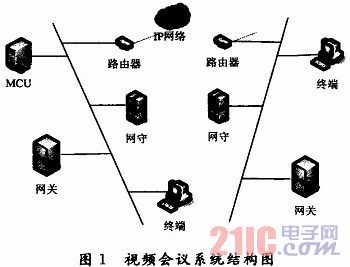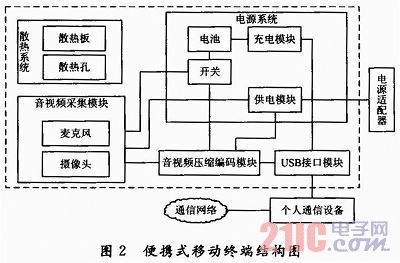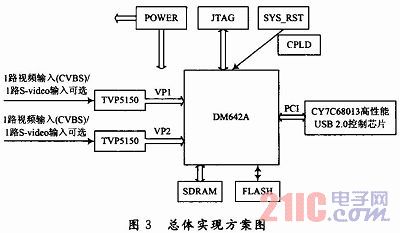
Privacy statement: Your privacy is very important to Us. Our company promises not to disclose your personal information to any external company with out your explicit permission.
Abstract: With the development of technology, video conferencing is widely used in various fields. This paper introduces the development of video conferencing systems, which are mainly composed of terminals, gatekeepers, gateways and MCUs, which implement different functions. Under the premise of the existing technology, in order to improve the performance of the video conferencing system, a H. based H. Design method and implementation of a portable video conferencing terminal for the 323 protocol and personal communication devices.
Keywords: video conferencing; H. 323; portable mobile terminal; audio and video compression coding module
0 Introduction With the development of communication technology integration, digitization, intelligence and personalization, and the maturity of computer network technology, the realization of voice, data and image services on the network platform has become the development goal and inevitable trend of the communication industry. . Traditional communication methods such as telephone and fax cannot meet the growing communication needs of people because they cannot achieve "face-to-face" communication. Video conferencing systems continue to evolve in this context.
The video conferencing system includes a software video conferencing system and a hardware video conferencing system, which refers to individuals or groups of two or more different places, through various existing electrical communication transmission media, to static and dynamic images, voices of characters, Text, pictures and other data are distributed to each user's computer, so that geographically dispersed users can gather together, exchange information through various means such as graphics and sound, and increase the mutual understanding of the content. Therefore based on IP network in accordance with H. The 323 standard video conferencing system received great attention. H. The 323 protocol establishes a multimedia communication system standard on Packet Based Networks (PBN) without QoS (Quality of Service) guarantee, which solves problems such as call and session control, multimedia and bandwidth control in point-to-point and multipoint video conferencing.
1 H. The structure of the video conferencing system of the 323 protocol A complete video conferencing system consists of a video conferencing terminal, a multipoint control unit (MCU), network management software (gatekeeper and gateway), a transmission network, and related accessories. The MCU is the nerve center of the whole system and is the main control device. It realizes the video conference by exchanging and controlling the local information collected by each conference terminal through the transmission network. Therefore, the information collected by the video conference terminal directly affects the progress of the conference.
This article refers to the address: http://

Video conferencing terminals are distributed in each venue. The basic function is that the image and voice input through the camera and microphone are compressed and encoded by the encoder, and the terminal is used to call the IP address or establish a dedicated line connection, and the data is transmitted to other sites, and the data transmitted from the network is decoded, and the image and sound are decoded. Restore to TV and stereo for real-time interactive communication with the far end. A terminal device typically includes a core codec, a camera, an omnidirectional microphone, and a remote control. There are currently four major video conferencing terminals:
(1) Conference room type, conference room video terminals are generally hardware-level special equipment, with high degree of product integration, with a variety of external interfaces, can be directly connected to the conference room audio and video system, such as mixers, split screens , projectors, multimedia speakers, TV sets, etc. In terms of the image output output by the system, the conference room video terminal can reach the full screen size of the TV. High-definition video and high-quality audio can be transmitted over a private network. It realizes a comprehensive multimedia remote conference platform integrating video interaction, audio interaction, screen broadcasting, remote control, text communication, electronic whiteboard, document sharing, file transmission and many other functions. Suitable for large enterprises, with high requirements on the network.
(2) Set-top box type, which contains all the hardware and software in one unit and is placed on the TV. Easy to install, lightweight, audio and video effects. Opening a video conference requires only a regular TV set and an ISDN BRI line or LAN connection. Video conferencing terminals can also load peripherals such as document projectors and whiteboard devices to enhance functionality. Main application: Set-top box terminals are usually shared resources between departments.
(3) Software video refers to the desktop terminal. The software relies on the PC camera and processor to exchange data with the outside world. It can effectively bring people at the desk or people who are traveling to your meeting to have face-to-face communication with you. This type of performance requirements for PC processors is relatively high, and the resolution of the built-in camera is also required. Main application: Desktop video conferencing terminals are usually assigned to special people in the office or people who work outside the office. Although desktop video conferencing terminals support multipoint conferences (for example, conferences contain more than 2 conference sites), most of them are used for peer-to-peer conferences.
(4) Telepresence is a new technology that creates a unique "face-to-face" experience on the network by combining high-definition video, audio and interactive components. Users will feel like sharing a room with the dialogue party, sitting next to the same "virtual conference table", being able to see each other, communicate with them, and even talk to other conference participants, sitting together like face to face. Its technical content is very high and costly. The main goal is to shorten the distance between users and important people, places and activities in their personal and professional life, and to communicate and cooperate more effectively. International clients, large corporations, and large commercial customers are all possible users, targeting major industries including government, financial services, healthcare, and manufacturing.
The conference room type and set-top box type have good performance but large size, high cost and are not easy to move. It is suitable for large and medium-sized enterprises. The performance of software video depends on the hardware configuration of the PC. The general effect is not ideal. The telecom technology has high complexity. The network resources are demanding and costly, and are suitable for international enterprises. In order to meet the needs of the public, a low-cost, high-performance portable video conferencing terminal based on personal communication equipment is proposed and implemented.
2 Design and implementation of portable video conferencing mobile terminals In view of the shortcomings of current video conferencing systems, it is unable to meet the needs of low-cost, high-performance, video conferencing anytime, anywhere, and proposes a personal communication device (such as a laptop computer, A portable video conferencing terminal design method for a network-connected television set, a processor-powerful smart phone, etc., the video conferencing terminal integrates an input module, an audio and video signal compression coding module, a power supply module, and the like in a portable terminal box. The USB communication method is connected to a personal communication device such as a personal computer or a mobile communication tool, and the video conference terminal client software automatically runs on the personal communication device, and the personal communication device can pass through the Internet (wired network, 3G network, WiFi wireless network). The video conferencing system can implement multi-party video conferencing, as shown in Figure 2.

As shown in FIG. 2, the solution includes an input module, an audio and video compression coding module, a USB interface module, a power module, a terminal client software module, and a heat dissipation system:
(1) The input module receives an input of a local audio and video signal. The input module mainly includes a microphone and an HD camera. The microphone receives the local audio signal input and the camera receives the input of the local video signal. The input module transmits the received audio and video signals to the audio and video compression coding module.
(2) The USB interface module is connected to the personal communication device through the USB connection mode, and the personal communication device is connected to the external network to access the video conference system to realize the video multi-party conference.
(3) The audio and video compression coding module is the core part of this solution. It compresses the audio and video signals received by the input module into a local compression code, provides the local compression code to the USB interface for transmission to the personal communication device, and then the personal communication device accesses the video conference system to the remote video conference terminal and the server through the external network. Send audio and video compression coding to achieve the purpose of information exchange.
(4) The power module includes a rechargeable battery, a power adapter, and a USB interface charging module. The power supply module has two power supply modes: directly supplying power to the video conference terminal through an external power supply of the power adapter; charging the battery through an external communication device via the USB interface, and providing video by the battery The conference terminal is powered.
(5) The video conference terminal client software includes a video and audio signal acquisition module, an audio and video signal playing module, and a remote audio and video signal receiving module. It is installed on a personal communication device. The audio and video signal acquisition module and the audio and video signal playing module are configured to control the collection and playback of the audio and video signals by the portable conference terminal, and the audio and video signal receiving module is configured to implement communication by the multi-party video conference terminal.
(6) The video conference terminal further includes a heat dissipation system, a heat dissipation plate and a heat dissipation hole for ensuring long-term stable operation of the terminal.
As shown in FIG. 2, the audio and video compression coding module is connected to the audio and video acquisition module and the USB interface module, and the audio and video compression coding module receives the local audio and video signals from the audio and video collection module, and compresses the signal into a local compression coding conforming to international standards. Transmitting the local compression code to the personal communication device through the USB interface module, and then transmitting the encoded signal to the outside through the communication network to which the personal communication device is connected. In addition, the personal communication device receives the remote compression coding in the video conference system through the connected communication network. The video conferencing client software is used for decoding, and the remote audio and video signals are restored to achieve the purpose of communication.
According to the above design method, the DM642 audio and video processor, built-in high-definition camera, microphone and some other hardware modules are used to realize the portable video conference mobile terminal. The overall implementation scheme is shown in Figure 3.

The DM642A multiprocessing platform is an evaluation development board based on TI's DSPTMS320DM642 chip design. It has a computing power of 4 GIPS and can be used for video capture, implementing complex audio and video compression algorithms with Ethernet ports and data. The DSP system power supply design module is the key, high-precision power supply can ensure the normal operation of the system. The system uses a 5 V power supply to drive two MOSFET DC-DC regulators (TPS54310) to supply the DSP core voltage CVDD (1.4 V) and the peripheral voltage DVDD (3.3 V). A Schottky diode is connected between the 3.3 V and 1.4 V supplies to ensure simultaneous powering of the DM642 core and external ports. TI's TPS54310 has an output accuracy of 1%, which fully meets the DSP's working requirements. The video input device SAA7113H, the video output device SAA7105H, and the CPLD all require 3.3 V supply, and the AMS1117-3.3 V is used to power these devices. The system is divided into six parts: system ground, video input ground, video output analog ground, audio analog ground and network analog ground. From the power supply is the system ground. In the PCB design, 220Ω and 100MHz magnetic beads are connected at a point between the local and the system ground. During debugging, as long as the power supply part works normally, the program can be downloaded to the DM642 through the JTAG port, and then other modules can be debugged.
The system uses DM642 as the core, including video input and output modules, storage modules, and communication modules. The DM642 integrates three video (Video Port, VP) ports. Each video port consists of 20 b data lines, two clock signals VPxCLK0 (input) and VPx-CLK1 (input/output). Each video port is divided. For the upper (B) and lower (A) channels, the VP0 A channel is multiplexed with the McBSPO, the VP1 A channel is multiplexed with the McB-SP1, the VP0 and VP1 B channels are multiplexed with the McASP, and the VP2 is single function. Pin. The input and output modules are composed of two decoders (TVP5150) and one encoder, which can input one channel of video at the same time and output one channel of video. The storage module is mainly composed of FLASH and two SDRAMs. In addition, the system also includes a JTAG emulation interface and a network port, which can easily communicate with the outside world. The basic working principle is that the input analog video signal is collected by the CCD camera, converted into a digital video signal by the video decoder, and sent to the DM642, and the DM642 uses the collected video data. The 264 standard code is compressed and transmitted to the PC through the USB interface, and then uploaded to the main conference of the video conference through the client software of the mobile terminal.
3 Problems to be solved Mobile terminal compatibility Due to H. The openness of the 323 protocol has caused some video conferencing system equipment manufacturers to modify the protocol to different extents. The standards are not uniform, and the compatibility of the mobile terminals designed with the other manufacturers needs to be improved.
High-definition Because it is a portable mobile terminal, the built-in camera is small in size and low in performance, and pixels cannot meet HD requirements.
Real-time QoS is especially important for communications. At present, there are many technologies for solving the Qos problem based on the IP network, but there is still no guarantee of real-time performance, and there is a certain transmission delay, resulting in delay or jitter of audio and video.
4 Conclusion In recent years, video conferencing has been increasingly used in people's communication and communication, which can use time and improve work efficiency efficiently and reasonably. Compared with traditional hardware video conferencing equipment, portable mobile conferencing terminals can utilize existing network environments and personal communication devices, and can provide audio and video quality and richer data collaboration functions that are not inferior to traditional hardware devices. It also greatly saves travel expenses and reduces the pain of traveling. As high-performance processors continue to evolve and costs continue to decrease, portable mobile conferencing terminals are an inevitable evolutionary process.
November 21, 2024
Enviar e-mail para este fornecedor
November 21, 2024

Privacy statement: Your privacy is very important to Us. Our company promises not to disclose your personal information to any external company with out your explicit permission.

Fill in more information so that we can get in touch with you faster
Privacy statement: Your privacy is very important to Us. Our company promises not to disclose your personal information to any external company with out your explicit permission.